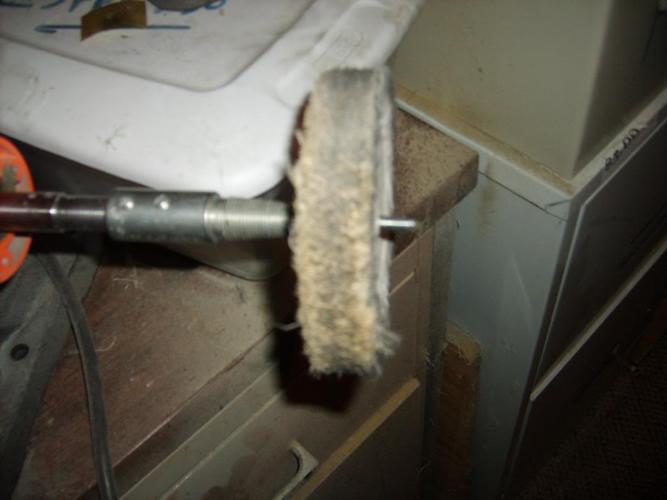Results 61 to 70 of 72
-
02-15-2013, 10:32 PM #61

I read page 1 and skipped to the last page no.6. Nice shop Glen it is great to see where the magic happens. I promise to read pages 2-5 at a later date.
Aloha,
ED
-
05-25-2013, 11:54 PM #62Junior Member

- Join Date
- May 2013
- Posts
- 16
Thanked: 1
You are the man!!!
-
10-27-2014, 07:11 PM #63Senior Member

- Join Date
- Jul 2014
- Location
- Boise ID
- Posts
- 102
Thanked: 8
This looks like a playground!!
-
08-31-2015, 02:44 AM #64

Love your setup and I'm just starting to get into mine, I have just recently found some helpful threads on restoration... those buffers you have seem like they are 1 speed 4 inch buffers... Or are they universal and can have any sized buffing wheel installed on them... Also with buffing and polishing is it okay just to have one speed or are u better off having one with variable speeds? In afraid I don't have the room nor the money to buy individual buffers for its own purpose so I have a 6 inch variable speed buffer that goes from anywhere between 2,000 to 3,400 rpm is that going to be sufficient for my greaseless compounds and my buffing and polishing? I know you can probably write a ten page answer so if u wanna make it in short that would be suffice... Thanks glen
-
08-31-2015, 05:28 AM #65Senior Member



- Join Date
- Apr 2012
- Location
- Diamond Bar, CA
- Posts
- 6,553
Thanked: 3215
You don’t need multiple buffers, just 2 wheels, for each grit or compound while one is drying, you are using the other.
I use 600 greaseless most, I keep 4, wheels loaded with 600 greaseless. 2 fully loaded and 2 stages of broke in. The broke in ones are great for lite cleanup and making jimps sparkle. I rotate them in as the greaseless wears, 2 fully loaded at a time. Mark your wheel with the grit on the side higher than your washers, I also mark rotation and install in the same rotation.
Buy a wheel rake, and rake before reloading for best performance and trim the wheel with a sharp scissor.
I don’t use a glove, it is way too dangerous, you need a solid grip on the razor and your fingers are the best temperature gauge. Quench at the slightest heat on your finger. If it’s too hot to hold, you probably ruined the temper. Do not use pressure, let the grit do the work, pressure builds heat… quickly. A razor can go from hot to damn hot very quickly.
The two best tutorials on buffing and polishing are the Tutorial on Caswell Plating and the Now and Zen of Metal Polishing, it is available as a PDF download from several places.
-
08-31-2015, 05:32 AM #66Senior Member



- Join Date
- Apr 2012
- Location
- Diamond Bar, CA
- Posts
- 6,553
Thanked: 3215
You don’t need variable speed, many of us have used the HF 3400 rpm 6 in buffer for years.
Smaller 3-4 in wheel are fine, 6in is too fast and dangerous for razors. Razors are thin and heat quickly.
-
The Following User Says Thank You to Euclid440 For This Useful Post:
bluesman7 (08-31-2015)
-
07-28-2016, 05:41 PM #67Junior Member

- Join Date
- Jun 2016
- Location
- Georgia
- Posts
- 6
Thanked: 0
Hi,
Which are the two grits before you get to emery? I am not really sure what grit my emery is but I need something a bit more aggressive to remove some scratches from a blade I am working on. Thanks
-
07-28-2016, 05:56 PM #68At this point in time...




- Join Date
- Jun 2007
- Location
- North Idaho Redoubt
- Posts
- 27,063
- Blog Entries
- 1
Thanked: 13249
-
The Following User Says Thank You to gssixgun For This Useful Post:
Submerj (07-28-2016)
-
07-29-2016, 04:23 AM #69Senior Member



- Join Date
- Apr 2012
- Location
- Diamond Bar, CA
- Posts
- 6,553
Thanked: 3215
Yea, 400 and 600 are the two I use most, I keep 3 wheels loaded with 600, fully loaded, half loaded and lightly loaded.
As one wear out the grit, I reload it and the others move up. I use the lightly loaded wheels the most, they will make rusty jimps gleam and clean dull razors steel quickly. 600 scratches buff out easily with greased compounds. Make sure to wipe off your greased compound from the razor frequently with WD40 or Brake cleaner on a paper towel.
You have to spend the time on the lowest grit needed, until you have removed the damage, if you need a lower grit, you need a lower grit, or decide to live with pitting.
I think the most common mistake folks make, is not spending enough time or use a low enough grit to remove deep scratches or pitting. If you don’t have greaseless, your hand sanding.
Buff barehanded and watch the heat.
-
07-29-2016, 04:12 PM #70

For those with only one buffer, I would suggest use of tapered adapters. They allow the quick change of buffing wheels. It is necessary to buy those which fit the diameter of the threading in the end of the buffer shaft.
I googled "Tapered buffer adapters"
https://www.google.com/search?q=tape...apters&imgrc=_
The shafts on the HF buffers are: 0.495 inch. I use a half inch bore with a piece of tin can wrapped around the shaft to protect the threads. Jewelery supply houses may have some at that exact size. I found some on ebay.
Get the pair as they are threaded opposite so the buff is retained by rotation on\off the shaft.

Cheers
~RichardBe yourself; everyone else is already taken.
- Oscar Wilde


 36Likes
36Likes LinkBack URL
LinkBack URL About LinkBacks
About LinkBacks






 Reply With Quote
Reply With Quote

